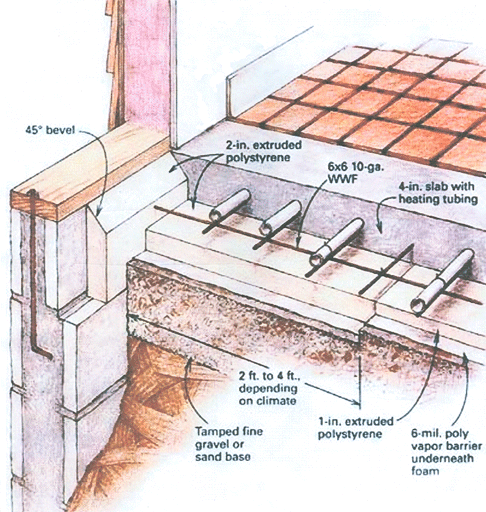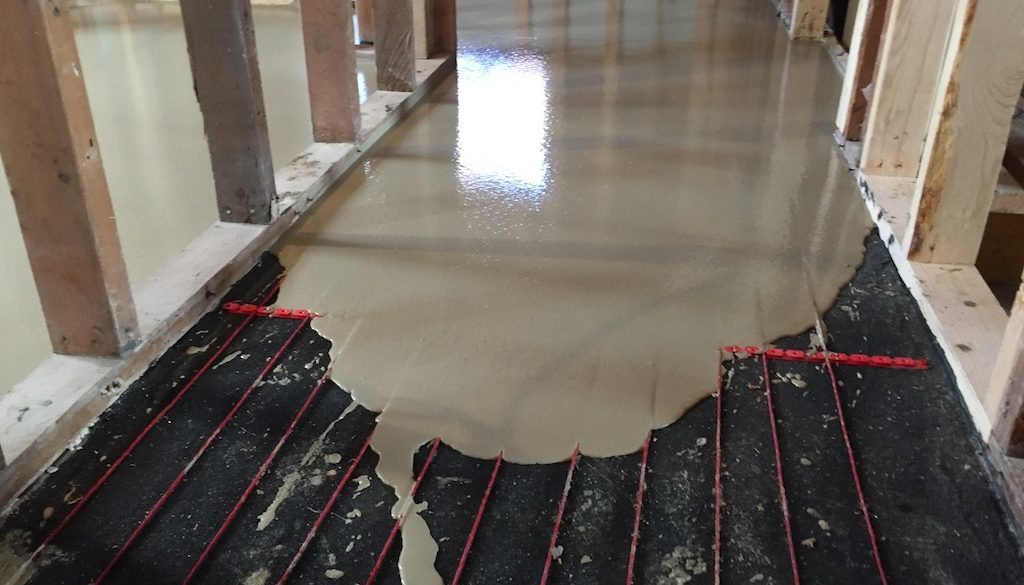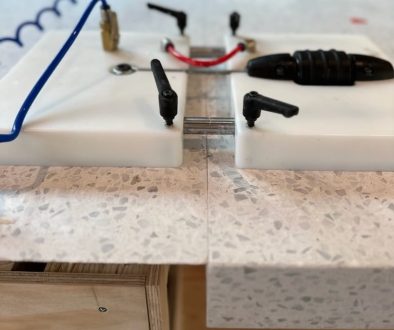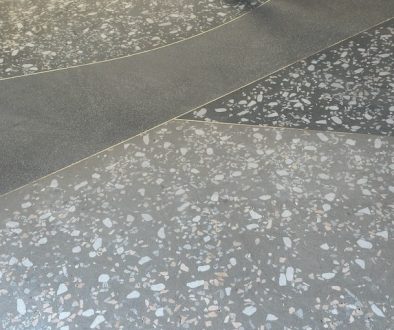Hydronic vs Electric – Heated Polished Concrete Floors
It is not surprising that the popularity of polished concrete for residential floors has grown in conjunction with advancements of in-floor heating technology.
Conventional underfloor heating systems use either electrical resistance elements (electric systems) or liquid flowing in pipes (hydronic systems) to heat the floor. Both types can be installed as primary heating systems or as localized floor heating for thermal comfort. Polished concrete can be integrated with both hydronic and electric heating systems.
With over 20 years experience with SD Concrete as both a designer and floor installer, I have been involved in over 300 residential concrete floor installations. I have seen many installation methods, some with better results than others.
Hydronic systems and the complex heating systems that work with them are usually installed in new construction. They are generally not a good choice for renovations.

Renovations of kitchens and bathrooms are usually to refresh and renew, they do not typically include heating system overhauls. This is why electric heating systems have been so popular with renovation contractors and home owners in the past ten years.
There is a big difference in overall floor thickness with each system. Typically hydronic systems utilize conventional concrete at an average thickness of 1.5” – 6” whereas electric systems use self levelling concrete mixes, and have a total thickness (including heating) of 3/4” – 1”.
There is no ‘one fits all’ solution. When choosing heated concrete flooring systems, one needs to consider: insulation and performance, energy efficiency, weight of materials, and overall costs of both the floor finish and heating system.
HYDRONIC HEATING SYSTEMS
Hydronic heating is ideal for homeowners that do not like forced air heating, and want to keep their home at a consistent, comfortable temperature. Hydronic systems can use a single source or combination of energy sources to help manage energy costs. Heat pumps or solar panels can be integrated into these systems to help save energy costs. Excluding the cost of the concrete (which is a necessity of the in-floor heating system), polished concrete typically ranges from $5 – $10 per sq/ft.
Process with slab on grade

-
level grade
-
6 mil vapour barrier
-
2” xps foam
-
rebar / mesh
-
pex tubing
-
concrete pour – 1.5” – 6”
hydronic advantages

- cost effective for new builds when it is integrated into the heating system in the planning stages.
- if a concrete slab is to be used in the construction, the concrete is already built into the budget.
- extra thermal mass of the concrete slab helps with energy efficiency.
- improved air quality compared to forced air.
- SCC (self consolidating mixes) can be utilized where placement/ access is difficult.
hydronic disadvantages
- initial costs for the system can be significant.
- not efficient for small renovations.
- using it for intermittent heating is not efficient. The system is designed to run at a constant temperature.
- takes up to 7 hours to warm up when first turned ON.
Polished concrete aesthetics for hydronic systems
Conventional concrete is typically poured at a 4″-6” thickness for hydronic applications. The concrete can be poured as a monolithic pour, or done as two separate slabs, one to encapsulate the heating system, the other as the finished flooring. Both methods have their advantages and disadvantages, consideration to construction process and schedule will likely determine the best process for your project.
Integral color

White or grey portland concrete can be utilized for the cement base color. White portland cement only comes in bags in the pacific northwest, and can double or triple the cost of the finished product. Titanium Dioxide can also be used to lighten the color of the concrete, it too is quite costly. Integrally coloring concrete to a darker or warm shade is quite simple, Davis Colors , or Interstar, both have great color charts and cost effective products.
Seeding the slab

Freshly placed concrete can be seeded with glass, stones, steel fillings or pretty much any hard material. They seeded materials are then floated into the surface and revealed through the grinding and polishing process.
see here for glass color options
Topical colors
Topical coloring can be done after the slab has cured and during the polishing process. These dyes penetrate into the concrete pores and are further protected with densifiers. This is not a process that wears off with time.
ELECTRIC HEATING SYSTEMS
If you want to heat a small zoned space like a single bedroom or bathroom, electric in-floor heating can be a great choice. These heated floors are powered by electric cables or mattes of electrically conductive plastic built in to the floor. Electric mattes or cables integrate well with homes that use forced air heating. When going over top of plywood sub floors, membranes are essential to control cracking in the polished concrete overlay.
There is very little information available related to concrete overlays and electric heating systems. Search terms such as: heated concrete overlays, self levelling heated floors, embedding electric heating in polished concrete overlays, and thin heated concrete floors yield pretty much useless information to date (currently Feb 2017).
Calls to the large manufacturers: Mapei, Rapid Set, and Ardex didn’t produce any useful information. Using self levelling concrete to cover heating cables is far from a new concept, using it as a finished polished concrete floor with electric matt systems is where there is a lack of information. To date, Stone Design has completed 8 projects of various types and sizes that integrate electric heating systems and polished concrete overlays. These have been some of our most stunning and near perfect floors to date.
costs – $10 – $16 per sq/ft
electric heating advantages
- can go over plywood sub floors. great for renovations.
nuheat cables ready to be covered - small areas (100 sq/ft+) can be done reasonably efficiently.
- head room – max 3/4″ total thickness with integral heating system.
- no special considerations for structural load.
- minimalist aesthetic.
- quick turn around – can be polished in 12-24 hours.
- simple installation methods keep costs reasonable.
electric heating disadvantages
- not as energy efficient as hydronic systems.
- self levelling products are expensive. when encapsulating heating cables, thicker pours are needed.
- floor prep for wood substrates requires an epoxy and/ or anti fracture membrane.
aesthetic options with electric systems
Heated polished concrete floors tend to fit aesthetically with most natural materials. The base ingredients (cement, sand, and aggregate), are found in nature and do well surrounded by similar materials. This means that modern homes, and their simplistic minimalist design are often complimented by polished concrete. Most engineered self- levelling concrete products contain very little aggregate, so grinding further into the slab does not mean larger aggregate. Polished self-levelling floors are usually more consistent and uniform when compared to conventional concrete. A cream finish aesthetic, without the busy look of sand and aggregate is much easier to achieve with self levelling products. Many customers ask about white or cream colored floors, achieving these aesthetics are completely possible with concrete overlays.







